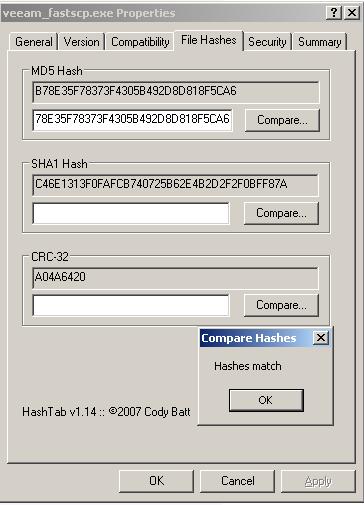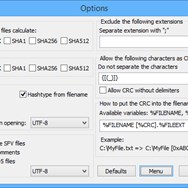

- #Windows hashtab hashcheck how to#
- #Windows hashtab hashcheck install#
- #Windows hashtab hashcheck software#
- #Windows hashtab hashcheck Offline#
The software works in the same exact way as HashCheck only that it adds an option to compare two files against each other as well as offering. You won't find a new context menu rather right-click on a file and select the Properties option. HashTab provides an easy way to verify file integrity and authenticity. HashTab is supported as a Windows shell extension. HashTab supports many hash algorithms such as MD5, SHA1, SHA2, RipeMD, HAVAL and Whirlpool.
#Windows hashtab hashcheck install#
Install the application and restart any Explorer window that is open so that the new menu option becomes visible. HashTab provides OS extensions to calculate file hashes. For that, you may use HashTab from Implbits. OpenHashTab is an open source utility that can be used to check file hashes from the Explorer context menu. In certain situations, you may also want to compare two files to confirm if they’re exactly the same or are different.
#Windows hashtab hashcheck how to#
How to Compare Hashes of Two Files using HashTab If you don’t require this feature, you can easily remove this item from the context menu by turning it off by clicking the Options button found in the Checksums tab. From there they can get the checksum which they can proceed to verify with their program of choice. If they don’t have the program, the checksum file is basically in plain text and as such can be opened by any text editor. If the recipient has this program installed, they only have to double-click the checksum and the program will do the rest by calculating and verifying the hashes.

Delta - Delta is an all-in-one classic video game emulator for non-jailbroken iOS devices.
#Windows hashtab hashcheck Offline#
Typically software venders do not publish hash checksums of their softwares, as hash check is usually used to check whether the file is original (not tempered with) and venders assume that a customer downloading software installer from their website does not need this information, as obviously the installer from their site is original (authentic).Creating Checksum File from the Context MenuĪfter that, you only need to package the file together with the checksum file or provide it separately. Another way is in Windows Explorer to right-click on the file you want to check and then select Validate and Calculate Checksum from the context menu. When comparing HashCheck and OpenHashTab you can also consider the following projects: gogcheck - Bash script that verifies your GOG offline installers authenticity and checksums. The checksum file should appear in the same folder.ĮDIT: I am sorry, I misunderstood your question. In addition to integrating file checksumming functionality into Windows, HashCheck can also create and verify SFV files (and other forms of checksum files, such as. The original Hashcheck is from 2009 but seems to work fine in Windows 10. You’ll get an extra tab called Checksums alongside the standard tabs of Compatibility, Details, Previous versions and etc. This Windows command example would return the SHA256 hash of the file located at the specified path. The HashCheck Shell Extension makes it easy for anyone to calculate and verify checksums and hashes from Windows Explorer. HashCheck HashCheck works in a slightly different way to a traditional checking tool because it integrates into the system’s file properties window. An example of this simple command is below: certutil -hashfile c:\Users\YourUserName\Desktop\wire.exe SHA256. add a new key under shell, naming it as you want to name the context menu item. After installation, the application simply adds a File Hashes tab in Windows’ File Properties dialog box, displaying information about the name of the hash and its value. Just a small writeup to easily check your files for the MD5 Checksum via the right click menu in the Windows Explorer: if you are a normal user. either go to properties and checksums tab or if you want the checksum to be saved in a separate file, right click on the file and select "create checksum file". A second more private way to check a file’s hash is to open the Windows command prompt and use the certutil command for Windows. Add MD5 Checksum to Windows Explorer context menu. After installing the utility, you go to a file or a set of files and right click. I recommend this above mentioned hashcheck utility, as I have used it extensively. I do not use the above mentioned utility, but I use something similar.

The checksum file should get saved in the same folder of the file you are calculating the checksum of.


 0 kommentar(er)
0 kommentar(er)
